How to allocate advertising budget effectively
The question of the optimal distribution of the advertising budget occupies many marketers. Especially at the end and beginning of the year.
What is an advertising budget?
The advertising budget is the money a company is willing to allocate towards a specific marketing channel: advertising. Often the advertising budget is a certain percentage of the entire marketing budget or even the company’s revenue.
Firstly, it must be defined how much advertising budget is available in total. Unfortunately, many companies still make the mistake of measuring this sum on the basis of irrelevant metrics, such as the percentage of sales or profit. We have written a separate article on the optimal calculation of the advertising budget.
This blog post is about how to allocate an advertising budget across different media platforms, campaigns, and formats.
Strategies of effective advertising budget allocation
Once the advertising budget has been determined, it must be properly distributed to the different levels of the sales funnel and also to the right advertising channels.
The 60 – 30 – 10 budget allocation rule
One rule of thumb is the 60/30/10 percent rule. This allocates 60% of the budget to awareness, 30% to consideration, and the remaining 10% to conversion.

This framework now helps to plan further campaigns.
Objective-based-budgeting strategy
Objective-based budget allocation is a strategic approach to distributing advertising budgets with precision and purpose. Instead of relying on arbitrary figures, this method prioritizes specific marketing goals and objectives.
By aligning budget allocation with key performance indicators such as ROI, customer acquisition, or brand awareness, companies can optimize their advertising spending for maximum impact and measurable results. This approach fosters accountability, efficiency, and a data-driven decision-making process, ultimately leading to more effective and targeted advertising campaigns.
Competitive parity in advertising budget allocation
Competitive parity involves setting your advertising budget based on what your competitors are spending. This strategy ensures that your marketing efforts are on par with industry standards, helping to maintain market share and visibility.
By closely monitoring and matching the investments of your competitors, you can avoid being outshined in key advertising channels.
However, the downside is that this approach may not align perfectly with your company’s specific goals or market position. It can lead to overspending if competitors have larger budgets or different objectives. Additionally, this reactive strategy may limit innovation, as it focuses on matching others rather than pioneering unique marketing initiatives.
Key factors to consider when allocating your advertising budget
Distribution of target groups
Not every target group leads to the same return on ad spend as another. For example, in B2B sales, company size might be related to revenue. However, larger companies may require a longer sales cycle and involve more people in the decision-making process. Accordingly, it requires more advertising budget than small companies.
In addition, there are also different roles in the buying process involved, such as the user, a champion, and a decision-maker. However, the weighting of influence may vary.
Often, companies have an Account Based Marketing (ABM) strategy that requires one or more audience targeting solutions.
Distribution of the advertising budget across platforms
A CPC (cost per click) cannot be compared in isolation with another CPC from a different advertising platform. Even one level down, the cost per lead (CPL) is not enough in the long run.
Business goals in marketing budget allocation
When allocating a marketing budget, aligning it with your business goals is crucial for effective spending. Whether the aim is to boost brand awareness, increase sales, or enter new markets, each goal dictates how and where funds should be allocated.
For instance, a goal focused on enhancing online presence would warrant a larger portion of the budget towards advertising formats like search ads and social media ads. Understanding and prioritizing these goals ensures that every dollar spent contributes directly to the overarching objectives of your business, maximizing the return on your marketing investment.
Competitive landscape in advertising budget allocation
Navigating the competitive landscape is a key factor in marketing budget allocation. Understanding where your competitors are investing can reveal market trends and untapped opportunities. If competitors are heavily funding digital ads, it might indicate a shift towards online platforms, suggesting a similar allocation for your budget.
Alternatively, identifying areas they overlook offers a chance to differentiate and capture a unique market segment. Balancing between matching industry standards and carving out a distinct position is essential, ensuring your marketing efforts are both competitive and innovative in the ever-evolving marketplace.
Marketing budget allocation example
| Google Ads | |||
| CPC | $2 | $2 | $6 |
| CPL | $20 | $25 | $60 |
| CPA | $200 | $180 | $175 |
In this marketing budget allocation example, I’m assuming Facebook Ads and Google Ads have a similar CPC but different conversion rates and therefore different costs per lead. However, the lead quality is not identical and the conversion rate from lead to a customer is also different.
In our example, even a significantly higher CPC and also CPL on LinkedIn can ultimately have the best cost per acquisition (CPA).
Therefore, each platform should be considered individually and an optimal advertising budget allocation per advertising channel should be calculated. Our free budget calculator helps with the forecast.
Allocation of the advertising budget to formats
There are a variety of advertising types and often a different CPX pricing structure. Display ads, for example, are often billed as CPM while Google Search Ads use CPC bids. The same platform (Google Ads in this case) uses different pricing models.
Add YouTube and video ads into the mix, and budget planning quickly becomes complex.
Therefore, formats should be linked to advertising targets and again fall within the 60/30/10 percent rule.
What are the true costs of advertising?
In addition to the media costs for placing the advertising, there are other costs. If media agencies take on the advertising, they usually charge a percentage of the media spend. In addition, ads (images, videos, and texts) must be created. This requires either additional spending or staff resources.
Landing pages should also be created, monitored, and optimized. Interfaces to CRM and email marketing systems also need to be secured and managed.
There are different approaches as to whether these and other additional costs should be included in the advertising budget. Mostly, only directly related advertising costs such as fees for ad agencies are included in the media planning budget.
Alternatives to advertising
What should I do if I don’t have enough advertising budget to generate the leads I need?
In addition to paid media, there is also owned and earned media. Owned media is where you create your own content, such as in SEO and content marketing, while earned media is where independent third parties talk or report about you. Press releases or customer reviews are good examples of earned media – as long as they are not purchased.

Sascha is a Lifecycle Marketing Consultant with over 8 years of digital marketing experiences in Silicon Valley, the UK, and Germany.
After leading the demand generation for a 100+ million company, he decided to venture out on himself. He’s now helping clients to attract and convert more leads and customers.
His main focus are SEO, paid media & marketing automation – all with the focus to tie marketing campaigns to revenue.
Sascha has been featured in industry publications.




